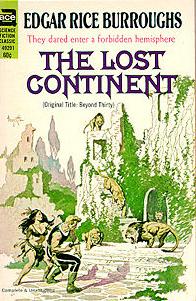Plot
The story was heavily influenced by the events of World War I, and reflects U.S. sentiments at the time of writing. When the war broke out, Americans were predominantly isolationist and wary of being drawn into a European war. Burroughs imagines a future two centuries onward in which that view prevailed and the western hemisphere severed contact with the rest of the world. Consequently, the eastern hemisphere has exhausted itself in war and Europe has descended into barbarism while the Americas, sheltered from the destruction, have continued to advance and joined peacefully into the union of Pan-America. By the twenty-second century the entire world east of the 30th meridian west and west of the 175th meridian west has become terra incognita to Pan-America.
In 2137, Pan-American Navy Lieutenant Jefferson Turck is commander of the aero-submarine Coldwater, tasked with patrolling the 30th meridian from Iceland to the Azores. Disaster strikes when the vessel's anti-gravitation screens fail, dooming it to wallow upon the surface of the ocean, and the engines fail, leaving it adrift. As its wireless radio has failed as well, Turck cannot even summon help. While the crew attempts repairs Turck and three subordinates, Snider, Taylor and Delcarte, go fishing in a small boat to reprovision the vessel. While they are out the Coldwater is successfully repaired and flies off, leaving the fishermen to their fate. It is implied that Turck's second officer Johnson, who has clashed with his superior, is behind both the original sabotage and subsequent abandonment.
Adrift, Turck and his companions are forced to make shore in forbidden England. They find it a wilderness inhabited by savages and overrun by lions descended from zoo animals. The British royal family has been reduced to the precarious leadership of a small tribe based near the ruins of London. While out hunting Turck rescues Victory, daughter of the king, from the henchmen of Buckingham, a local strongman who has killed her father. He tries to return her to her family, only to fall himself into Buckingham's hands. The two escape and flee to London, where they find evidence that Great Britain had fallen fully two hundred years before; the Great War had destroyed the Old World's civilization in less than a quarter century.
Turck and Victory join the other Americans, and the combined party sails to the European mainland, also reduced to savagery. There Snider dies after attempting to seize Victory for himself. Soon after, Turck and Victory fall separately into the hands of soldiers of the Abyssinian Empire, a black super-state now ruling all of Africa, most of Europe, and the Arabian Peninsula. While the Abyssinians' technology is roughly equivalent to that of the nineteenth century, it is more than a match for the white savages populating Europe. The Abyssinians consider whites a lower order and take them as slaves. Turck too is pressed into slavery, becoming the personal servant of Belik, an Abyssinian colonel.
Turck's master takes him to New Gondar, built on the site of ancient Berlin, where the Abyssinian Emperor, Menelek XIV, holds court. Menelek is portrayed as gross and cruel—perhaps once a great man, but now corrupted by power. Turck watches powerlessly as white slave women are offered to the emperor for his harem, including his love interest Victory. Turck rescues Victory during an attack on New Gondar by the forces of China, which have been advancing into Europe from the east. The couple is captured by the invaders, but made honored guests once the Chinese have heard their story. They are taken to the Chinese base on the site of old Moscow, and eventually by rail to Peking, where the two wed.
Meanwhile, back in Pan-America, Turck's subordinate Alvarez argues for his superior’s rescue, the ban on travel to the Eastern Hemisphere is rescinded, and a search and rescue expedition is mounted. Taylor and Delcarte are found, communications between the hemispheres are re-opened, and diplomatic relations established between Pan-America and China, with commerce to follow. Turck, hailed as a hero, makes plans to restore Victory to her British throne.

Edgar Rice Burroughs was an American writer, best known for his prolific output in the adventure, science fiction, and fantasy genres. Best-known for creating the characters Tarzan and John Carter, he also wrote the Pellucidar series, the Amtor series, and the Caspak trilogy.

The Western Hemisphere is the half of the planet Earth that lies west of the Prime Meridian and east of the 180th meridian. The other half is called the Eastern Hemisphere. Politically, the term Western Hemisphere is often used as a metonymy for the Americas, even though geographically the hemisphere also includes parts of other continents.

Russell George Manning was an American comic book artist who created the series Magnus, Robot Fighter and illustrated such newspaper comic strips as Tarzan and Star Wars. He was inducted into the Will Eisner Award Hall of Fame in 2006.

Roy Gerald Krenkel, who often signed his work RGK, was an American illustrator who specialized in fantasy and historical drawings and paintings for books, magazines and comic books.

Tarzan, Lord of the Jungle is a novel by American writer Edgar Rice Burroughs, generally considered the eleventh in his series of twenty-four books about the title character Tarzan. It was first published as a serial in Blue Book Magazine from December 1927 through May 1928; it first appeared in book form in a hardcover edition from A. C. McClurg in September 1928.

Tarzan and the City of Gold is a novel by American writer Edgar Rice Burroughs, the sixteenth in his series of twenty-four books about the title character Tarzan. The novel was originally serialized in the magazine Argosy from March through April 1932.
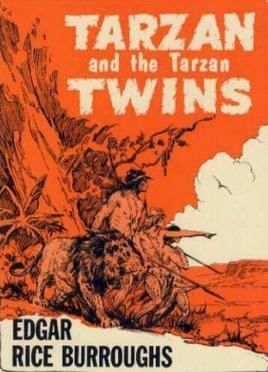
Tarzan and the Tarzan Twins is a collection of two Tarzan novellas by American writer Edgar Rice Burroughs, for younger readers. It was originally published as two children's books, The Tarzan Twins by Voland in October 1927, and Tarzan and the Tarzan Twins, with Jad-bal-ja, the Golden Lion, by Whitman in March 1936. These were brought together in November 1963 under the title of Tarzan and the Tarzan Twins in the first complete edition.
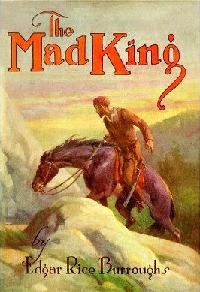
The Mad King is a Ruritanian romance by American writer Edgar Rice Burroughs, originally published in two parts as "The Mad King" and "Barney Custer of Beatrice" in All-Story Weekly, in 1914 and 1915, respectively. These were combined for the book edition, first published in hardcover by A. C. McClurg in 1926.

Tanar of Pellucidar is a novel by American writer Edgar Rice Burroughs, the third in his series set in the interior world of Pellucidar. It first appeared as a six-part serial in The Blue Book Magazine from March–August 1929. It was first published in book form in hardcover by Metropolitan Books in May 1930.

Tarzan and the Valley of Gold is a 1966 Eastmancolor adventure film starring Mike Henry in his debut as Tarzan. The Panavision film, produced by Sy Weintraub, written by Clair Huffaker, and directed by Robert Day, is remembered for its very James Bond-like portrayal of a tropical suited, globetrotting Tarzan. It was released on July 1, 1966.

Tarzan the Fearless is a 12 chapter American Pre-Code film serial starring Buster Crabbe in his only appearance as Tarzan. It was also released as a 61-minute feature film which consisted of the first four chapters edited together, and which was intended to be followed on a weekly basis by the last eight chapters in individual episode format, but which was often exhibited instead as a stand-alone feature film. Actress Jacqueline Wells co-starred; she later changed her name to Julie Bishop. The serial was produced by Sol Lesser, written by Basil Dickey, George Plympton and Walter Anthony, and directed by Robert F. Hill. The film was released in both formats on August 11, 1933.

The Battle of Shire was a battle fought on the northern front of what was known as the Second Italo-Abyssinian War. This battle consisted of attacks and counterattacks by Italian forces under Marshal of Italy Pietro Badoglio and Ethiopian forces under Ras Imru Haile Selassie. This battle was primarily fought in the Shire area of Ethiopia.

Llana of Gathol is a collection of four science fantasy stories by American writer Edgar Rice Burroughs, which were originally published in Amazing Stories in 1941. The first collected edition of Llana of Gathol was published in 1948 with an apparently new foreword. It is the penultimate book in the Barsoom series and the last to be published during Burroughs's lifetime.

The Man-Eater is a short adventure novel by American writer Edgar Rice Burroughs, written in May 1915, originally as a movie treatment. His working title for the piece was Ben, King of Beasts. The Man-Eater is one of Burrough's rarer works. It was first published as a serial in the New York Evening World newspaper under the present title from November 15–20, 1915, but did not appear in book form in Burroughs' lifetime. The first book edition was issued by Lloyd Arthur Eshbach's Fantasy Press fanzine in 1955; it then appeared in the collection Beyond Thirty and The Man-Eater, published by Science-Fiction & Fantasy Publications in 1957. It was reprinted in paperback as The Man Eater: Ben, King of Beasts by Fantasy House in 1974.

Beyond Thirty and The Man-Eater is a collection of two short novels by Edgar Rice Burroughs. Both were written in 1915; The Man-Eater, a jungle adventure, was first published as a serial in the New York Evening World newspaper from November 15–20, 1915, while Beyond Thirty, a science fiction story, was first published in All Around Magazine in February 1916. Neither work appeared in book form in Burroughs' lifetime. The first book versions were limited editions were issued by Lloyd Arthur Eshbach's Fantasy Press fanzine in 1955; the two works were then published in a combined edition under the present title by Science-Fiction & Fantasy Publications in 1957, through which they first reached a wide readership. Both works have since been published separately.
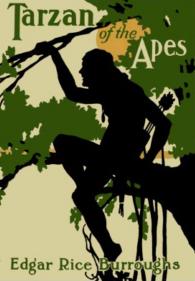
Tarzan is a series of 24 adventure novels written by Edgar Rice Burroughs (1875–1950) and published between 1912 and 1966, followed by several novels either co-written by Burroughs, or officially authorized by his estate. There are also two works written by Burroughs especially for children that are not considered part of the main series.

Renegade of Callisto is a science fantasy novel by American writer Lin Carter, the eighth and last in his Callisto series. It was first published in paperback by Dell Books in August 1978, and reprinted once, in November of the same year. A tribute to Edgar Rice Burroughs's The Chessmen of Mars, the book introduces the game of Darza, Carter's equivalent of Jetan. An appendix details the rules.

Black Legion of Callisto is a science fantasy novel by American writer Lin Carter, the second in his Callisto series. It was first published in paperback by Dell Books in December 1972, and reprinted twice through January 1974. The first British edition was published by Orbit Books in 1975. It was later gathered together with Jandar of Callisto into the omnibus collection Callisto: Volume 1 (2000). The book includes an appendix collating background information from this and the previous volume.

As the Axis powers of Germany, Italy, and Japan cemented their military alliance by mutually declaring war against the United States on December 11, 1941, the Japanese proposed a clear territorial arrangement with the two main European Axis powers concerning the Asian continent. On December 15, they presented the Germans with a drafted military convention that would delimit the continent of Asia into two separate "operational spheres" by a dividing line along the 70th meridian east longitude, going southwards through the Ob River's Arctic estuary, southwards to just east of Khost in Afghanistan and heading into the Indian Ocean just west of Rajkot in India, to split the Lebensraum land holdings of Germany and the similar spazio vitale areas of Italy to the west of it, and the Empire of Japan to the east of it, after a complete defeat of the Soviet Union by the Third Reich.
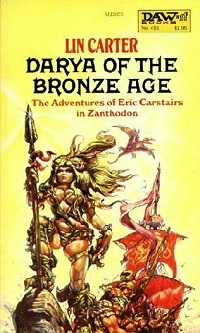
Darya of the Bronze Age is a science fiction novel by American writer Lin Carter, the fourth in his series about the fictional "Hollow Earth" land of Zanthodon. It was first published in paperback by DAW Books in September 1981, with an ebook edition following from Gateway/Orion in October 2018. It was also gathered together with the other volumes in the series into the omnibus ebook collection The Zanthodon Megapack.

